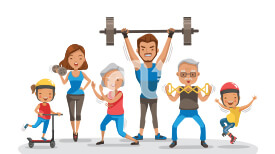12 Easiest Ways How to Improve Balance
Balance is vital for people of all ages. If you wonder how to improve my balance, you can find it in this blog post. Now, we’ll take a look at the best balance exercises for both kids and adults.
The Best How to Improve Balance Exercises
Engaging in exercises that focus on stability and coordination is key to improving balance. Here are some of the best exercises that’ll help you understand how to improve your balance over time.
1. MentalUP Fitness Module
MentalUP is the one and only app that combines physical education and cognitive development. MentalUP’s fitness module is not like any others.

MentalUP is an engaging exercise platform that enables both adults and kids with regular exercise plans. If you're wondering how to improve balance and coordination while enjoying quality time with your family, MentalUP offers an ideal solution.
This module features an extensive variety of balance, stretching, cardio, and enjoyable gymnastic exercises tailored for all ages, making it the perfect choice for those seeking ways to enhance balance and coordination.
How to improve flexibility and balance while keeping your mind active? MentalUP is the answer! Because its exercises come with user-friendly instructional videos and require no specialized equipment, ensuring accessibility for everyone in your family. 💪
But that’s not all! MentalUP also provides 150+ fun brain training games to boost both your and your kids’ cognitive skills. It is time to enhance both your mental and physical abilities, anytime and anywhere with MentalUP! 🚀
2. Weight Shifts
If you're wondering how to improve standing balance, weight shifts are your answer. Weight shifts are a fundamental balance exercise that can significantly enhance stability. It involves shifting your body weight from one foot to the other while maintaining an upright posture.

By practicing this exercise regularly, you can improve proprioception the body's awareness of its position in space, leading to better balance control. This exercise is suitable and beneficial for individuals of all ages.
To perform it, stand with your feet hip-width apart, then gently shift your weight onto one foot while keeping the other foot slightly lifted. Hold the position for a few seconds before shifting your weight. Repeat this movement for a designated duration, gradually increasing the time as your balance improves.
3. Single Leg Balance
Would you like to learn how to improve single-leg balance? Well, it's pretty simple with regular single-leg balance exercises. These exercises are great for enhancing stability, coordination, and strength in the lower body.

Improved balance through this exercise can benefit individuals of all ages, especially those involved in sports that require agility and quick movements.
To perform the exercise, stand on one leg while slightly bending the knee of the other leg. Engage your core muscles to help you balance. Hold this position for as long as you can. For added challenges, you can try closing your eyes or moving your lifted leg in different directions.
4. Tai Chi
Tai Chi, an ancient Chinese martial art, is a holistic exercise that combines gentle, flowing movements with deep breathing and mental focus. Practicing Tai Chi regularly enhances balance, flexibility, and overall body awareness.

Practicing Tai Chi is especially beneficial and suitable for kids aged 8 and up as it enhances their emotional regulation and body awareness. So, if you want to learn how to improve children's balance, you can consider Tai Chi.
To practice Tai Chi, individuals need a quiet space and should follow a Tai Chi routine or join a class led by an experienced instructor. You'll notice that your kids have improved balance, reduced stress, and increased relaxation as they progress.
5. Yoga
Yoga is a holistic practice that combines physical postures, breathing exercises, and meditation to promote balance, flexibility, and mental well-being.

Yoga poses target balance and stability by engaging different muscle groups and improving body awareness. Regular yoga practice not only strengthens your muscles but also enhances your proprioception, leading to better balance control.
If you're interested in learning how to improve balance with eyes closed, incorporating yoga into your routine can be beneficial. Consider joining a beginner-friendly yoga class or following online tutorials, ensuring you practice under the guidance of a certified yoga instructor.
MentalUP is here to help you explore how to improve your balance and can be your partner in discovering the full potential of all family members! MentalUP supports its users with hundreds of brain games and fitness exercises. 🎮 🏀 🎵 🏈
Also, it has no ads feature. You will see the results by yourself with rich performance-tracking tools and different reporting modules. Your personal trainer is just a click away, accessible on all devices. 🎉
You can transform your fitness journey into an overall development together with your kids!
6. Pilates
Pilates is a high-impact exercise method that emphasizes core strength, flexibility, and overall body awareness. It incorporates controlled movements and specific breathing techniques to engage the muscles and improve balance.

Pilates exercises target the core muscles, including the abdominals, back, and pelvis, which play a significant role in maintaining stability. So, it might be a great option if you want to explore how to improve stability and balance with easy movements.
To create a Pilates routine, you can search online for videos created by Pilates instructors or consider taking classes. With consistent practice, you’ll not only improve your balance and stability but also notice improvements in your posture.
7. Back Leg Raises
Back leg raises are simple yet effective balance exercises that target the glutes and lower back muscles. If you're wondering how to improve balance and stability in your lower muscle groups, you can try these exercises.

Back leg raises can be incorporated into any individual's exercise routine, especially for teens and young adults.
To perform this exercise, stand upright with your feet hip-width apart. Slowly lift one leg straight back without bending your knee. Keep your back straight and engage your core muscles for stability. Hold the raised position briefly before lowering your leg back down.
8. Toe Stand
The toe stand is a balancing exercise designed to enhance ankle stability by strengthening the muscles in the feet and ankles. It not only improves overall balance but also enhances proprioception, making it one of the best how to improve your balance exercises.

This exercise is particularly beneficial for children older than 7 years and for athletes, dancers, and seniors aiming to enhance their balance.
Begin by standing with your feet hip-width apart. Slowly rise onto your tiptoes, lifting your heels off the ground. Balance on the balls of your feet for a few seconds before lowering your heels back down.
9. Squats
Squats are a versatile exercise that targets the quadriceps, hamstrings, and glutes. They improve balance by strengthening the muscles in the legs and core, enhancing stability and coordination.

To perform a squat, stand with your feet shoulder-width apart. Lower your body as if you were sitting back in a chair, keeping your chest up and your back straight. Proper form is crucial to engage the right muscles and maintain balance during the exercise.
Go as low as your flexibility allows, then push through your heels to return to the starting position. Squats can be a great exercise if you are wondering how to improve your sitting balance.
10. Tree Pose
Tree Pose, also known as Vrksasana in yoga, is a standing balance posture that helps improve balance, stability, and concentration. It might be one of the best poses if you are wondering how to improve balance on one leg.

Tree Pose is suitable for individuals of all ages but is especially beneficial for young children as it also supports their stress management skills and promotes relaxation. To perform the exercise, start by standing on one leg and lifting the other foot, placing the sole against the inner thigh or calf of the standing leg.
Press your palms together at your chest in a prayer position or extend your arms overhead like branches of a tree. Fix your gaze on a point in front of you to maintain balance.
11. High Lunge
If you are wondering how to improve dynamic balance, you should definitely try High Lunge. It is a dynamic yoga pose that targets the legs, hips, and core muscles, enhancing balance and coordination. This pose is best suited for kids older than 12 and adults.

To perform this exercise, start in a standing position and step one foot back into a deep lunge, ensuring your front knee is directly above your ankle. Reach your arms overhead, engaging your core muscles to maintain balance.
High Lunge improves balance by requiring you to stabilize on one leg while strengthening the muscles in both legs.
12. Plank
The Plank exercise is a fundamental bodyweight movement that targets the core muscles, shoulders, and arms while promoting overall body stability. Regularly practicing Planks not only enhances balance but also leads to a better posture and a reduced risk of injury.

This exercise is suitable for individuals of all ages, and its difficulty level can be adjusted based on individuals' fitness levels. So, if you are wondering how to help improve balance for your kids or yourself, you can try plank pose.
To perform a Plank, start in a push-up position with your hands placed directly under your shoulders and your body forming a straight line from head to heels. Engage your core muscles and hold this position for as long as you can, aiming for proper alignment and stability.
The Benefits of Improving Balance at Any Age
So far, we have explored how to improve balance exercises. Now, let’s take a closer look at all the benefits of improving your balance with regular exercise.
1. Boosting Brain Health
Improving balance through regular exercise has a profound impact on brain health. Balance exercises stimulate the brain's neural pathways, enhancing coordination and sharpening cognitive function.

Engaging in activities challenging balance, such as yoga or Tai Chi, encourages the brain to create new connections, improving memory and concentration.
A strong sense of balance can also reduce the risk of cognitive decline as we age, promoting long-term brain health and overall mental well-being.
You can discover how to improve balance and cognitive skills simultaneously! MentalUP keeps its users' minds and bodies active with daily personalized fitness and brain training plans, entailing hundreds of games and exercises. 👏
Plus, MentalUP can be used on any PC, tablet, or smartphone. Don’t forget that it has 10 million users, keeping their skills sharp worldwide. 🌎
2. Preventing Accidents and Falls
One of the key benefits of balance exercises is their role in preventing accidents and falls, especially in older adults. Balance training strengthens muscles and improves proprioception, the body's sense of its position in space.

This increased awareness and stability significantly reduce the risk of stumbling and falling. By enhancing balance, individuals gain confidence in their movements, making it easier to navigate uneven terrain and daily activities, ultimately lowering the likelihood of accidents and injuries.
3. Enhancing Core Strength and Stability
Improving balance inherently involves strengthening the core muscles, which play a crucial role in maintaining stability. Core muscles include the abdominals, lower back, and pelvis, and they act as a strong support system for the entire body.

Balance exercises engage these muscles, leading to enhanced core strength and stability. A robust core not only improves balance but also supports the spine, reduces the risk of back pain, and enables better posture.
4. Stress Reduction and Relaxation
Engaging in balance exercises, particularly those rooted in mindfulness like yoga and meditation, has a profound impact on stress reduction and relaxation.

These exercises encourage focused breathing and mental concentration, promoting a sense of calm and tranquility. By concentrating on maintaining balance, individuals immerse themselves in the present moment, letting go of worries and stressors.
This mindfulness, combined with the physical benefits of improved balance, leads to reduced stress levels, enhanced relaxation, and an overall improved sense of well-being.
Important Tips How to Improve Balance and Stability
Now that we have explored how to improve balance and flexibility, let’s discover some insightful tips to help you as you work on your balance.

- Engage in regular strength training exercises to build muscle stability.
- Practice balance exercises on unstable surfaces like balance boards.
- Include yoga and Tai Chi in your fitness routine to enhance body awareness.
- Focus on core strengthening exercises to improve overall stability and posture.
- Work on proprioception exercises to enhance stability.
- Maintain proper footwear to provide adequate support.
- Try agility exercises to improve your body's ability to react quickly.
- Enhance your balance through mindful practices such as meditation.
- Consider consulting a physical trainer for personalized balance training programs.
- Don’t forget that balance improvements often come with consistent practice.
- Incorporate apps into your daily routine that support physical activity and cognitive development in a personalized way.
Frequently Asked Questions
If you still need answers about how to improve balance quickly or how long to improve balance, the commonly asked questions below can help.
How long does it take to improve balance?
Improving balance varies greatly from person to person and depends on factors like age, fitness level, and dedication to exercise. Generally, consistent balance exercises can show a noticeable improvement within a few weeks to a few months.
How to improve a child's balance?
To enhance a child's balance, engage them in activities like riding a bike, MentalUP balance exercises, or practicing yoga. These activities help develop their coordination and strengthen their core muscles, which are crucial for maintaining balance.
How to improve baby balance for walking?
Babies develop balance skills through stages. To aid their progress towards walking, encourage tummy time to strengthen neck and core muscles. Provide stable objects to hold onto, such as furniture or your hands, allowing them to practice standing.
Long story short, whether you need to improve your balance or support your family members to improve theirs, it is essential to practice with sources that provide cognitive enhancement and physical improvement.
Support your family members with MentalUP’s safe and fun learning environment!
MentalUP helps its users discover how to improve balance quickly and supports their overall development. That's why it's an Evidence of Impact awarded app used by millions of parents, kids, and teachers. 👪
Ready to improve focus, memory, problem-solving, and other skills while maintaining physical prowess? It is time to start using MentalUP now! 🔥





